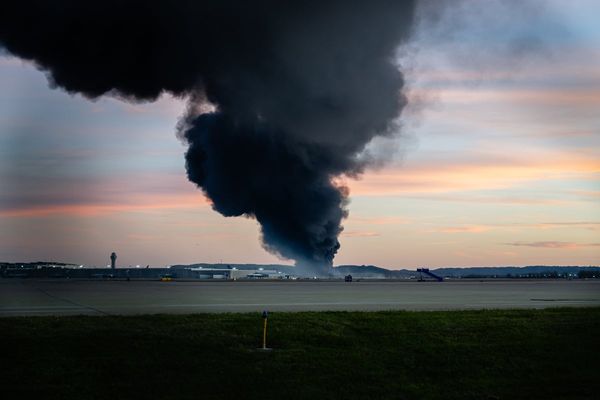
Kremlin agitation in the Black Sea increases risk of direct conflict with military alliance
Since Vladimir Putin launched a full-scale invasion of Ukraine, Nato has scrambled to present a united front against Russia.
- SEE MORE What the Wagner uprising in Russia might mean for the Ukraine war
- SEE MORE Nato’s new plans to defend Europe from Putin
- SEE MORE Will Nato use Ukraine membership as a bargaining chip with Russia?
Although member states have plied Kyiv with weapons, as well as punishing Russia with the most severe economic sanctions ever imposed on a major economy, they have wavered on Ukraine’s bid to join the alliance.
Nato has refused to offer a clear timeframe for Ukrainian membership, with the tacit understanding that it could lead to a direct conflict with Russia. But the alliance’s suggestion that Ukraine could join after the conclusion of the war will only “encourage Putin to keep fighting”, said Carnegie Institute’s Judy Dempsey.
The latest
Moscow has created a “real risk” of sparking a direct conflict with Nato by intercepting ships in and out of Ukraine in international waters, one of the alliance’s former top commanders warned last week.
“Russia’s actions in the international waters of the Black Sea create a real risk of escalating this to a war at sea between Nato and the Russian federation,” ex-US admiral James Stavridis told Politico. Nato “is not going to provide all the weapons and money for Ukraine, only to watch Russia strangle their economy with an illegal blockade”.
Tensions in the Black Sea have “increased dramatically” since Russia withdrew from a UN grain deal in July, “and warned that ships travelling to Ukrainian ports could be seen as military targets”, the news site said.
“If Russia starts seizing vessels or seeks to scare them away, I think it likely Nato will respond by supporting a humanitarian corridor for shipping,” Stavridis said. The alliance could protect vessels going to and from the Ukrainian port of Odesa “with Nato combat aircraft overhead and possibly Nato warships in escort”.
Meanwhile, Ukraine’s foreign minister described talks at the start of August as a “breakthrough” for Kyiv.
Officials from more than 40 countries, including China, India and the US, met in Jeddah to discuss a 10-point plan proposed by Zelenskyy to end the war. The talks were seen “as an attempt by Kyiv to build a broader coalition of power to support its vision of peace”, said Al Jazeera.
Zelenskyy said he left Nato’s latest summit in Lithuania last month with a “significant security victory” after a G7 declaration of long-term support guarantees. But the agreement, while providing for military equipment, training and intelligence sharing, stopped short of offering a definitive timeframe for Ukraine’s accession to the security alliance.
Nine Eastern European nations that joined Nato after the Soviet collapse in 1991, including Bulgaria, Estonia, Hungary, Latvia and Poland, and collectively described as the “Bucharest Nine”, issued a “stirring call to arms” a month earlier, said The Guardian, insisting that countering Russian aggression was “the only way to restore peace and the rules-based order in Europe”.
Nato’s capability
A mutual assistance clause sits at the heart of the security alliance, which was formed in 1949 with the express aim of countering the risk of a Soviet attack on allied territory. Article 5 of Nato’s Washington Treaty says that an attack on one ally is considered an attack on all member states. This is “one of the main reasons why Ukraine cannot join Nato while in conflict with Russia”, Reuters said.
A Nato pledge asks members to spend 2% of gross domestic product on defence. And though less than a third of members meet this target, Nato Secretary-General Jens Stoltenberg has said it is “increasingly considered a floor, not a ceiling”.
But there are some military big hitters in the alliance. The US spends more on defence than the next ten big spenders in the world combined. Its total in 2022 was estimated to be $877 billion, according to Trading Economics. Russia was in third place, on £86 billion, behind China. The UK sits in sixth place, with spending of £68.5 billion.
Nato’s biggest player, the US, boasts a powerful arsenal and a huge amount of manpower. According to World Population Review figures, it has 1.39 million active troops, beaten only by India and China.
In total, Nato has around 3.36 million active military personnel, Statista data indicates.
But Nato is only offering Ukrainian soldiers “basic training”, reported openDemocracy after speaking to one frontline brigade, leaving them “underprepared for the realities of Russia’s war” because of a “disconnect” between Nato and domestic training. This shifts “the burden of vital combat training back to Ukraine”.
Russia’s capability
Despite Russian forces’ well-publicised struggles in Ukraine, their overall military capability is considerable. The country went from the fifth largest defence spender in the world in 2021 to the third in 2022, with a jump of more than £20 billion.
It has 1.33 million active military personnel, according to Statista, but only around 4,182 military aircraft compared with Nato’s combined 20,633, and 598 military ships compared to Nato’s 2,151.
“Russia’s ground combat vehicle capacity is more competitive,” said Statista. However, “the combined nuclear arsenal of the United States, United Kingdom, and France amounted to 5,943 nuclear warheads, compared with Russia's 5,977.”
There has been “much speculation” about Russia's preparedness for a long war, said Sky News, “with some Soviet-era or older weaponry still in circulation and questions over its effectiveness and suitability in modern combat situations”.
Many experts believe Russia’s military effectiveness has been dented by the disbanding of the Wagner Group after its abortive mutiny. James Horncastle, an assistant professor in international relations, noted for The Conversation that Wagner Group soldiers “were responsible for many of Russia’s early successes”.
Russia’s “blundering army” could not beat Ukraine’s 2nd XI, said The Guardian’s foreign affairs commentator, Simon Tisdall, “even when sober and with the wind behind it”.
Nato vs. Russia
The US has an overwhelming advantage over Russian troops. This month, Joe Biden said he would request an additional $24 billion from Congress for Ukraine, “and other international needs related to the war”, said Al Jazeera.
Biden and his team have said the US will help Ukraine “as long as it takes” to remove Russia.
For all his threats, said Tisdall, “Putin fears Russia-Nato conflict”. For him, it would be “political and military suicide”.
But Russian journalist and military analyst Pavel Felgenhauer told DW that open warfare often comes down to far more than the inventories that each side can call upon.
“It’s like predicting the result of a soccer match: yes, basically, Brazil should beat America in soccer, but I have seen Americans beat Brazil in South Africa,” said Felgenhauer. “You never know the result until the game is played.”







